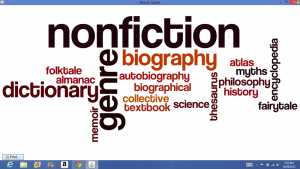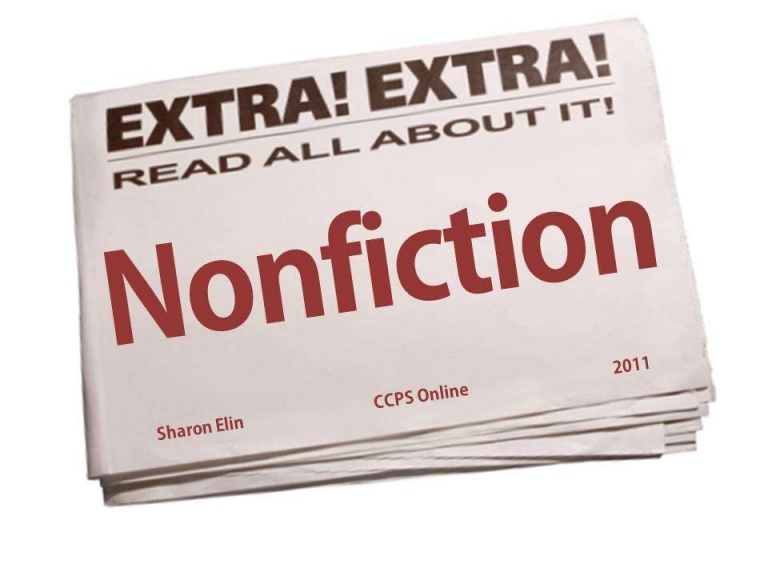I used to think of nonfiction as solely consisting of autobiographies and textbooks. (Ok, I knew of other examples in the genre, but these are the main examples that came to mind.) However, after taking Introduction to Nonfiction this year I realized that I really enjoy the other side of nonfiction, such as the Personal essays and Memoirs, or areas of journalism, that we have had to read and write so far.
According to Dictionary.com, nonfiction is described as “the branch of literature comprising works of narrative prose dealing with or offering opinions or conjectures upon facts and reality, including biography, history, and the essay (opposed to fiction and distinguished from poetry and drama )” (Dictionary.com). Though I am more of a fiction writer, I have realized that I could also be interested in working with nonfiction as well. Therefore, I will also have to think how this genre circulates, how it is delivered, and how it spreads. 
According to “Why Media Spreads“from Spreadable Media by Henry Jenkins, Joshua Green, and Sam Ford, “circulation is concerned with making audience members into receptacles for mass-produced and mass-distributed content” and “circulation…signals a movement toward a more participatory model of culture, on which sees the public not simply as consumers of pre-constructed messages but as people who are shaping, sharing, reframing, and remixing media content in ways which might not have been previously imagined”(Jenkins). However, the book also mentions that “those definitions of “circulation” are really talking about distribution, where the movement of media content is largely—or totally—controlled by the commercial interests producing and selling it” (Jenkins).
Circulation of the nonfiction genre can vary based on the text. For example, textbooks can be circulated by teachers or students for specific classes, when they are needed and discussed. However, personal essays or memoirs from authors can be circulated through word of mouth – from other authors or audiences that are interested in the piece – as well as in person with the purchase of the pieces. Articles about events in the news can also be circulated online through different websites and then shared on different aspects of social media as well. This genre, in an academic sense, may have less circulation than the prose aspect and even less than the fiction genre. Textbooks are not often talked about, remixed, or discussed and therefore may not have as much circulation besides being assigned for different courses or assignments. Journalistic pieces however, may be talked about online on social media and then circulated to other platforms or areas to reach larger audiences.
The delivery aspect of nonfiction is broad as well. For example, a textbook may be distributed in classrooms in print text or may also be assigned online through a PDF or online textbook. In a publishing house, Memoirs or Personal Essays can be distributed in print in books or can also be found online in a digital format. News articles may be delivered to audiences online and through print as well.
“Why Media Spreads” describes spreadability as “referring to the technical resources that make it easier to circulate some kinds of content than others, the economic structures that support or restrict circulation, the attributes of immediate text that might appeal to communities motivation for sharing material, and the social networks that link people through the exchange of meaningful bytes” (Jenkins). In addition to spreadability, the text also mentions “stickiness” which ” broadly refers to the need to create content that attracts audience attention and engagement… sticky content is
 material that people want to spread.” No, the text is not referring to spreadability as in Jelly or Peanut butter on a sandwich, but instead talks about how spreadability through text helps it connect to a larger audience. The text also mentions that much of this content is through formats that make it easy to share. My immediate thought is how quickly news spreads. Journalism is an aspect of nonfiction that I am not fully interested in, but am interested in how it spreads so quickly. When a major event occurs that event is immediately documented in newspapers and online sources. This information can then be spread to other platforms, such as on social media, and can be personalized later with comments, reviews, or opinions.
material that people want to spread.” No, the text is not referring to spreadability as in Jelly or Peanut butter on a sandwich, but instead talks about how spreadability through text helps it connect to a larger audience. The text also mentions that much of this content is through formats that make it easy to share. My immediate thought is how quickly news spreads. Journalism is an aspect of nonfiction that I am not fully interested in, but am interested in how it spreads so quickly. When a major event occurs that event is immediately documented in newspapers and online sources. This information can then be spread to other platforms, such as on social media, and can be personalized later with comments, reviews, or opinions.
Nonfiction is a large genre that consists of many forms, but it is interesting to see how many ways it can be circulated, delivered, and spread across different platforms and texts.
word count: 740 (whoops)
JENKINS, HENRY. FORD, SAM. GREEN, JOSHUA. SPREADABLE MEDIA: Creating Value and Meaning in a Networked Culture. NEW YORK UNIV PRESS, 2018.
“Nonfiction.” Dictionary.com, Dictionary.com, www.dictionary.com/browse/nonfiction.
“SlideShare.” SlideShare, LinkedIn Corporation, 13 Jan. 2011, www.slideshare.net/sharonelin/nonfiction-6552161.
“PinkyReader.” PinkyReader, PinkyReader, www.pickyreader.com/nonfiction-genres.html.
“Ilovepeanutbutter.” Ilovepeanutbutter, Peanut Butter & Co, 2018, recipes.ilovepeanutbutter.com/peanut-butter-and-jelly-day/.
